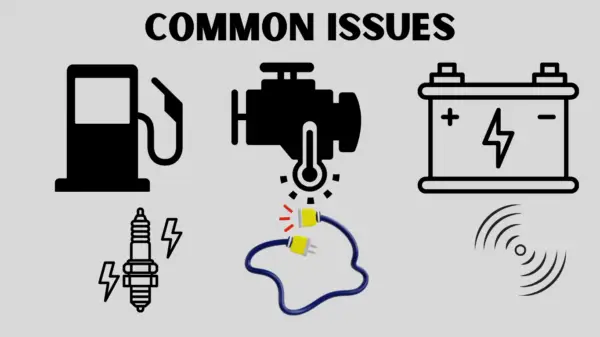
The purpose of driving is to be enjoyable and safe. But, a lot of drivers fret about what happens if my car shuts off while driving but starts back up . This could make you feel uneasy. In this article we will explain the most the most common causes and provide easy steps to resolve the issue. The way we write is a casual and clear style using simple words. Our aim is to help you to understand and solve the problem with your vehicle.
Introduction
If my car shuts off while driving but starts back up it can be frightening. It is possible to feel nervous when driving when this happens. Knowing the causes is crucial to ensure safe driving. In this article we will discuss the reasons, solutions and preventive steps. We focus on simple, practical tips to help you gain confidence at the wheel. Be aware that if this issue arises there’s an answer.
What Does This Issue Mean?
This issue means that your engine ceases to run for a short time and then restarts. Consequently, many drivers are concerned because it could indicate a more serious problem. Moreover, although it may seem like a random occurrence at first, there are, in fact, several possible reasons that we will explore in depth.
Common Causes

The common causes for my car shuts off while driving but starts back up are given below:
1. Fuel System Problems
A clogged fuel filter or a weak fuel pump can disrupt fuel flow.
- Blocked Filter The accumulation of dirt and other debris can block the filter.
- Poor Pump The pump that is failing could not provide enough fuel.
- Fluid Lines Leaking Leaks decrease the amount of fuel that is available for engines.
These issues could cause a temporary stop, and then the engine will recover.
2. Ignition System Faults
Spark plugs that are not functioning properly or an old ignition coil could result in malfunctions.
- Spark Plugs Dirty or worn-out plugs could not generate an explosive spark.
- Ignition Coil A defective coil causes disruption to the spark required for combustion.
A misfire could cause a short slowdown before the engine can compensate.
3. Battery and Alternator Problems
The alternator and battery in your car are connected to supply power.
- Poor Battery: An aging or damaged battery may drop the voltage.
- Failure of the Alternator: If the alternator isn’t charging correctly the power could not be sufficient.
Such power problems could cause a temporary shutdown followed by the restart.
4. Sensor and Computer Glitches
Modern vehicles depend on sensors and onboard computers.
- Sensors with faults: A bad sensor (like the crankshaft sensor) could send out incorrect signals.
- ECU Glitch: Engine control units may be able to reset its own.
This may cause a short delay until the system fixes itself.
5. Overheating
In the event of overheating, your vehicle may have to shut down in order to ensure the engine is protected.
- Low Coolant A lack of coolant can result in high temperatures.
- Faulty Thermostat An HVAC system that fails could not properly regulate temperature.
Once the engine cools down, it could restart by itself.
6. Electrical System Issues
Electrical problems can cause intermittent engine shut-downs.
- loose wiring: Vibrations may cause connections to slack.
- Relays or Bad Fuses: These components may malfunction and cause power to be cut off for a short period of time.
This might cause a temporary power loss before things get back to normal.
Troubleshooting Steps
Take these steps to determine and possibly fix the issue of my car shuts off while driving but starts back up:
Inspect the Fuel System
- Fuel Tank Make sure the tank’s filled.
- leaks Check for fuel line leaks.
- The Pressure Test Verify the level of fuel using an instrument.
- Fuel Filter Repair: Replace a clogged fuel filter, if needed.
Examine the Ignition System
- Spark Plugs Check for damage or wear.
- Ignition Coils Examine their results.
- Connecting to the Internet: Check all wiring for secure connections.
- Parts Replacement Replace worn components.
Evaluate Battery and Alternator
- Voltage Test: Test the battery’s voltage.
- Alternator Output Make sure the alternator is charged correctly.
- Clean terminals Clean any corrosion.
- Replace as needed: Consider a new alternator or battery if it is damaged.
Scan for Error Codes
- OBD-II scanner: Connect the scanner to scan for error codes.
- Record Errors: Note sensor-related or electrical problems.
- Get a professional’s help: If codes persist and persist, seek help from a professional.
Monitor Engine Temperature
- Limit of Coolant: Make sure the coolant level is the correct level.
- Thermostat function: Verify that the thermostat shuts and opens in a correct manner.
- Radiator Verify: Inspect for blockages or leaks.
- Temperature Gauge Be aware of the gauge when driving.
Verify Electrical Connections
- Conducting a Wiring Inspection: Look for any frayed or loose wires.
- Fuse Verify: Replace any blown fuse.
- Secure Connections Secure any terminals that are loose.
- Relays for Tests: Replace any relays that may be faulty.
DIY Fixes
A lot of fixes are easy enough for DIY for my car shuts off while driving but starts back up. Be careful while working on your car.
Fuel System Maintenance
- Change Filters Filters that are blocked could restrict fuel.
- Clean fuel lines Clear away any debris that could block an efficient flow.
- Choose Quality Fuel: Choose reputable fuel stations to get better quality.
Ignition Maintenance
- Replace Spark Plugs Replace them at least every 30000 miles.
- Check Coils Check and change as needed.
- Maintenance Wiring Examine the wires regularly to see if they are worn.
Battery and Alternator Care
- Regular Cleaning: Clean battery terminals monthly.
- Test for Voltage: Test output during regular maintenance.
- Replace old parts: Consider new components when they’re more than three years old.
Sensor and Computer Fixes
- reset ECU Remove the battery from your computer for short time for the system to be reset.
- Clear codes: Make use of the OBD-II scanner to eliminate error codes.
- Change Sensors Replace the defective sensors as soon as you can.
Cooling System Upkeep
- Coolant Level Checks Always check regularly for and replenish coolant levels.
- Thermostat Evaluation: Replace if it fails to function.
- Maintenance of Radiators: Clean out any obstructions to ensure the proper cooling.
Electrical System Repairs
- Inspect Wiring Look for damaged or loose wires.
- Replace Connectors with Corroded Connections: Make sure that all electrical connections are secure.
- Test Relays and Fuses: Replace as needed to ensure that you have a reliable power source.
When to Seek Professional Help
Certain problems require the attention of a specialist. Take a look at a mechanic
- The issue occurs frequently.
- Error codes persist despite resets.
- You may notice strange scents, or even visible smoke.
- The engine can overheat frequently.
A qualified mechanic will run thorough diagnostic tests and employ sophisticated tools to identify the problem. Choose a certified mechanic for the safety of your family and for proper repairs.
Preventive Maintenance Tips
Regular maintenance helps prevent many problems. Follow these tips:
Regular Service Checks
- Lubrication: Change oil every three to five miles.
- Air Filters Refill them according to the is recommended.
- Spark Plugs Make sure they are in good working order.
- Coolant Keep track of levels and flush out the system on a regular basis.
Dashboard Monitoring
- Warning Lights: Never ignore dashboard alerts.
- Unusual Sounds: Listen for odd engine sound effects.
- performance changes: Note any changes in acceleration.
- Reads on Temperature: Keep an eye on the heat of your engine.
Maintenance Log
- Record Service Dates Monitor when maintenance work is completed.
- Note Problems: Document any recurring issues.
- Schedule Future Services: Plan regular check-ups.
- Reviews Repairs It helps to identify the patterns that are issues that are recurring.
Use Quality Parts
- OEM Parts: Stick to original OEM parts from the manufacturer.
- Original Products: Opt for original products; consequently, the longer they last, the better.
- Avoid Cheap Replacements: Moreover, avoid cheap replacements because they may fail earlier.
- Make a bet on reliability: Quality parts ensure an efficient operation.
Real-Life Experiences
Learn from other people will help you comprehend the problem more clearly.
Story 1: Fuel Filter Failure
One motorist was unable to move in the roadway. The reason was a clogged fuel filter. After the filter was replaced the fuel filter, the engine continued to run smooth and without interruptions.
Story 2: Ignition Troubles
Another driver experienced misfires that were caused by damaged spark plugs. After replacing the spark plugs, the sparks stopped and the car started consistently.
Story 3: Sensor Glitch
Sensor failures led to the stalling of intermittently. A technician replaced the defective sensor and the issue was solved for good.
Advanced Diagnostics
If the basic fixes don’t result, try these advanced methods:
Computer Diagnostics
Modern vehicles are equipped with computers that save errors and codes. Make use of the OBD-II scanner to find and eliminate these codes. This procedure helps pinpoint the root of the issue.
Wiring Inspection
The causes of electrical issues can be hidden. Professionals can examine the wiring. Fixing broken or loose connections is often the solution to periodic stoppages.
Fuel Pressure Testing
A gauge for the pressure of fuel can help to determine if your engine’s fuel filter or pump are malfunctioning. Check your readings against the specifications provided by the manufacturer. A low pressure could indicate the need for replacement.
Sensor Calibration
Sensors may require calibration to function properly. A trained professional can alter or replace sensors, making sure they are sending precise signals to computers.
Safety First
Your safety is of paramount importance. Be extra cautious when your vehicle behaves in a strange manner.
Tips for Safe Driving
- Be calm: If the engine is stalled, be calm and evaluate the situation.
- Safety: Use your hazard lights and make your way to a secure zone.
- Request for Help: If the issue persists, contact roadside assistance.
- Avoid long trips: If instability continues Avoid driving for long distances.
Emergency Checklist
- Make sure you have a charged phone: For emergencies.
- Know your Roadside Numbers: Have contacts for assistance.
- Stay Visible: Use reflective gear if needed.
- Plan Routes Take care to: Avoid heavy traffic until the problem is solved.
Expert Advice
Experts recommend a few basic techniques to prevent problems with the engine:
Listen to Your Car
Your car is often able to provide subtle warning signals. Unusual sounds or vibrations point to potential issues. Being aware can allow you to spot problems earlier.
Regular Inspections
Check your vehicle with professionals every year at a minimum. Regular inspections can help identify problems before they turn into serious issues.
Use Quality Fuel
The quality of the fuel used affects the engine’s performance. Make sure to choose reliable fuel stations to lessen the chance of clogs and unsatisfactory performance.
Stay Updated on Recalls
Sometimes manufacturers recall vehicles due to problems that are known to be present. Staying informed about recalls can aid in identifying potential problems prior to them becoming dangerous.
Maintenance Checklist
Here’s a short checklist to ensure that your car stays in good shape:
- Fuel System Make sure you are checking filters, pumps as well as fuel lines.
- ignition system: Check the spark plugs as well as coils.
- The battery and the alternator Always test them and make sure to clean.
- Sensors and ECUs: Scan for error codes.
- Cooling System Check the levels of coolant and thermostat.
- Electrical Systems: Examine wirings, relays, and fuses.
- General Maintenance: Follow the service program and use only high-quality components.
Frequently Asked Questions
Q1: Why is my car turn off for a short time?
A: Different factors like ignition, fuel, battery sensors, overheating or electrical problems can lead to short stalls.
Q2 Do I have the ability to fix this issue by myself?
A Certain fixes, like cleaning filters or replacing filters can be done by yourself. However, issues that are persistent require the attention of an expert.
Question 3: Can you drive safely when this happens frequently?
A: No. Stalls that are frequent and often repeated pose a safety danger and demands immediate attention.
Question 4: Which maintenance regimen should I be following?
A: Follow the instructions in your vehicle’s instruction manual for oil changes on a regular basis as well as filter replacements and regular inspections.
Q5: How can I tell if a sensor is defective?
A: A sensor that is not functioning properly frequently produces error codes. Utilize the OBD-II scanner or talk to an expert mechanic to determine the cause.
Conclusion
If my car shuts off while driving but starts back up the next day, it’s extremely confusing and a source of worry. We’ve looked into the most common causes — fuel ignition, battery, sensor, overheating and electrical issues. We have also offered solutions to troubleshoot, DIY steps and expert guidance. Regular maintenance is essential to avoid problems like these. Always put safety first and seek advice from an expert if the issue persists. If you take the proper care you will be able to ensure that your vehicle is running smoothly and have a pleasant, stress-free driving.

